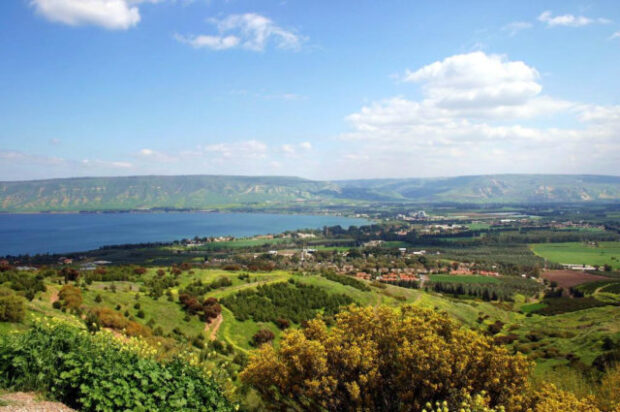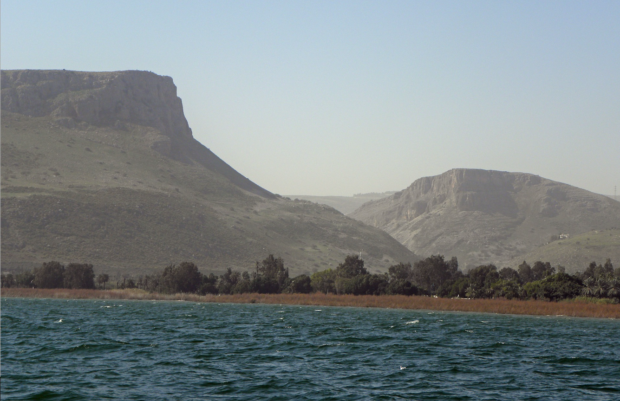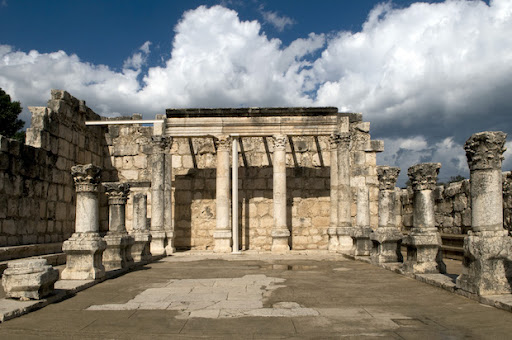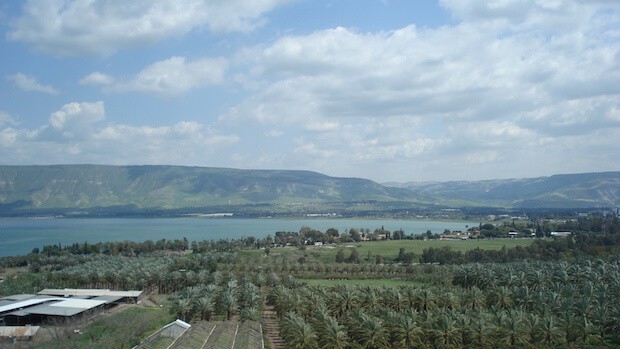Quiet Capernaum (Kfar Nahum or “Nathan’s village”) wraps around the northwestern shore of the Sea of Galilee. It’s surrounded by lush, rolling hills that invite easy living—likely the reason a large number of Jews migrated there from Jerusalem after returning from Babylon.
Of this region the first-century Jewish historian Josephus wrote:
The country that lies over against this lake has the same name of Gennesaret; its nature is wonderful as well as its beauty; its soil is so fruitful that all sorts of trees can grow upon it, and the inhabitants accordingly plant all sort of trees there; for the temper of the air is well mixed, that it agrees very well with those types, particularly walnuts, that require an air that is more moderate. One may call this place the ambition of nature, where it forces those plants that are naturally enemies to one another to agree together; it is a happy contention of the seasons as if every one of them laid claim to this country.

I’ve been to Capernaum five times, and I’ve found this 2,000-year-old description to be as accurate today as it was back then. I’ve thought: “If I were Jesus, I would’ve picked it for my ministry headquarters, too.”
There were other towns and cities in the lower Galilee region that might seem like good locations to launch a movement that would change the world.
Yet Jesus chose this remote fishing village as his temporary home, and it would become the hub of his ministry activities:
Leaving Nazareth, he went and lived in Capernaum, which was by the lake in the area of Zebulun and Naphtali (Matt 4:13; see also Matt 8:13; Luke 4:31).
Why not Magdala or Bethsaida—or even Jerusalem, the center of religious activity in Israel?
Though a lush and tranquil place to call home, Jesus might have had other reasons for choosing Capernaum.
A strategic location among the nations
In a previous post, I talked about the importance of trade routes and how they functioned as a bridge connecting the nations surrounding biblical Israel. The Via Maris (also called the “Way of the Sea” in Isa 9:1) was one such route, connecting Egypt to Syria.1
The Via Maris ran along the northwestern shore of the Sea of Galilee and west-southwest beneath the cliffs of Arbel toward Mount Tabor and the Jezreel Valley, then on through the Carmel Range via the Megiddo pass.

Jews and Gentiles from all over the world traversed these roads, and almost all traffic to and from Damascus funneled through Capernaum.
Capernaum also fell within the boundaries of the tetrarchy of Herod Antipas, who made it the center of customs and tax collection in his region.
This is why we encounter Roman centurions and tax collectors in stories set in Capernaum:
And getting into a boat [Jesus] crossed over and came to his own city. … As [he] passed on from there, he saw a man called Matthew sitting at the tax booth, and he said to him, “Follow me.” (Matt 9:1, 9 NIV, emphasis mine)
When [Jesus] had entered Capernaum, a centurion came forward to him. (Matt 8:5)
What a strategic place to reach people. Lots of people.
Jesus’s move from Nazareth to Capernaum was not a retreat into remoteness but a deliberate move into a more diverse region where his message and impact could have a wider and more receptive audience.2
News of the miracles done in Capernaum would have spread throughout the known world because of the volumes of people traveling through the city.
They would have heard how Jesus:
- Healed a nobleman’s son (John 4)
- Cast out a demon in the synagogue (Mark 1)
- Healed a man lowered through the roof (Mark 2)
- Healed a centurion’s servant. (Matt 8 & Luke 7)
- Gave the Bread of Life discourse (John 6)
And they didn’t keep this information to themselves:
Capernaum had excellent connections to surrounding districts from which visitors and transients came in contact with Jesus. . . . Overwhelmed by Jesus, they returned to their homeland as his emissaries, heralding their incredible experiences as they went.3
Fulfilling prophecies
That same man “sitting at his tax booth” (Matt 9:1) would later write that Jesus went to live in Capernaum to fulfill what was said through the prophet Isaiah:
“Land of Zebulun and land of Naphtali, the Way of the Sea, beyond the Jordan, Galilee of the Gentiles—the people living in darkness have seen a great light; on those living in the land of the shadow of death, a light has dawned.” From that time on Jesus began to preach, “Repent, for the kingdom of heaven has come near. (Matthew 4:14–16, quoting Isaiah 9:1)

Magdala was not by the Jordan River.
Nazareth was not by the Sea of Galilee.
Bethsaida was not in the region of Zebulun and Naphtali.
Only Capernaum met Isaiah’s criteria. Jesus brought a message of grace, love, and repentance—“light” to those who sat in spiritual darkness, including Matthew himself.
The message resounded from quiet Capernaum.
As is God’s habit, Jesus chose what is small for great things.
***
Understanding the geography of Israel enhances our understanding of the narrative of the Bible. For more information on the geographical, cultural, and historical settings in the Bible, I recommend the Holman Bible Atlas: A Complete Guide to the Expansive Geography of Biblical History and the award-winning Lexham Geographic Commentary on the Gospels.

- Brisco, Thomas V. Holman Atlas Bible, “International Highways,” (Broadman & Holman) 1998.
- Aubrey L. Taylor, “Capernaum: A Strategic Home for the Messiah,” in Lexham Geographic Commentary on the Gospels, ed. Barry J. Beitzel and Kristopher A. Lyle, Lexham Geographic Commentary (Bellingham, WA: Lexham Press, 2016), 84.
- Perry G. Phillips, “The Crowds That Followed Jesus,” in Lexham Geographic Commentary on the Gospels, ed. Barry J. Beitzel and Kristopher A. Lyle, Lexham Geographic Commentary (Bellingham, WA: Lexham Press, 2016), 120–121.





